5 ways to improve your digital banking security
Dos and don’ts for a safe mobile banking experience

Mobile banking and digital payments are convenient, simple, fast and flexible — allowing us to access our accounts and make payments anytime on the go. But along with this convenience comes added risk. Today, 78 per cent of UAE consumers worry about their financial information being stolen online, according to the Norton Cyber Security Insights Report 2017.
The same report found that of those who have experienced cybercrime, more than a quarter (29 per cent) have had payment information stolen from their mobile device over the past year. If you use mobile banking, you need to protect your phone and your financial information from hackers, identity thieves and malware. Here are our top tips on how to stay safe:
1. Security software
Install mobile security software and keep it up to date. Don’t forget to install updates for your device operating system and banking app too as they become available. You’re more vulnerable to evolving threats if you have outdated versions of apps and software. It’s important to backup your data so that you can recover it if necessary. Get a theft tracker for your mobile device, so that if it’s lost or stolen you can locate it via GPS, remotely lock it and wipe your data.
2. Set PINs and passwords
Protect your phone/tablet with a strong password and set up a SIM card PIN so that it can’t be used in another device. The process varies for different android devices, so contact your product manufacturer or vendor for advice. Make sure you don’t use the same numbers as your ATM PIN. Use strong passwords for your bank account login. Do not disclose your mobile banking password or PIN to anyone. Make sure you don’t store account login details, any passwords or account numbers on your mobile device. Keep them safely stored elsewhere. In fact, don’t store any sensitive personal data on your device. If you’re recycling your phone or passing it on to someone, make sure you delete all such personal information first.
3. Use official apps
Verify that a banking app is official before you download and install it. If you have any doubts, check with your bank first. Using your bank’s app avoids the risk of you logging on to fake sites. Remember to log out of the app or mobile site when you’ve finished.
4. Phishing bait
Beware of unsolicited texts or emails asking you to disclose your secure PIN, passwords or usernames as they will probably be phishing attempts. Always tell your bank about any suspicious emails or texts you receive. Don’t click on dubious links in emails or texts and never send financial information by unencrypted email.
5. Avoid risky Wi-Fi
Don’t carry out sensitive financial transactions using public Wi-Fi or unknown networks. The open nature of public networks makes them vulnerable — you never know who may be poking around and watching what you’re doing online.
Make sure you use a secure connection when making any financial transaction or communicating with your bank. You can get around these issues by disabling Wi-Fi on your device and using your cell network instead. It’s good practice anyway to turn off Wi-Fi and Bluetooth when you’re not using them.
— The writer is Chief Technology Officer for Emerging Markets, Symantec
Sign up for the Daily Briefing
Get the latest news and updates straight to your inbox



